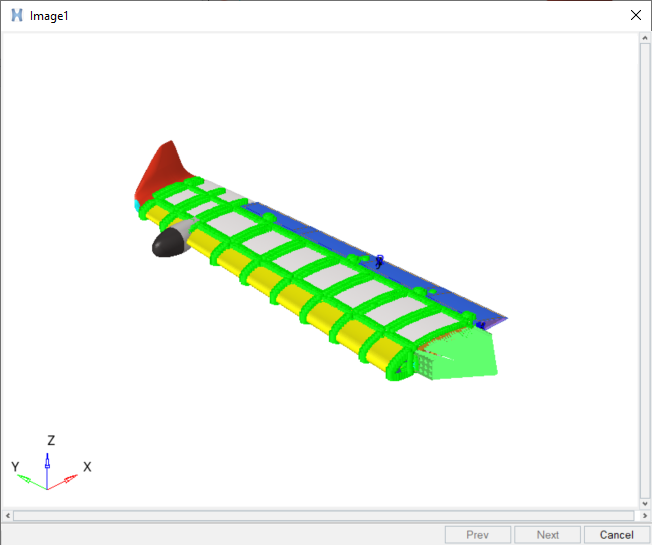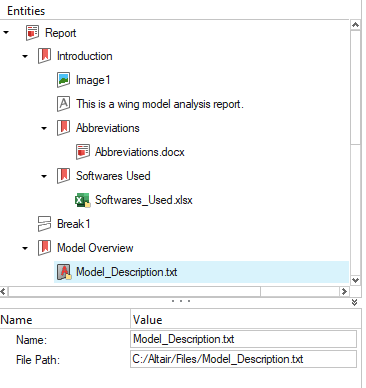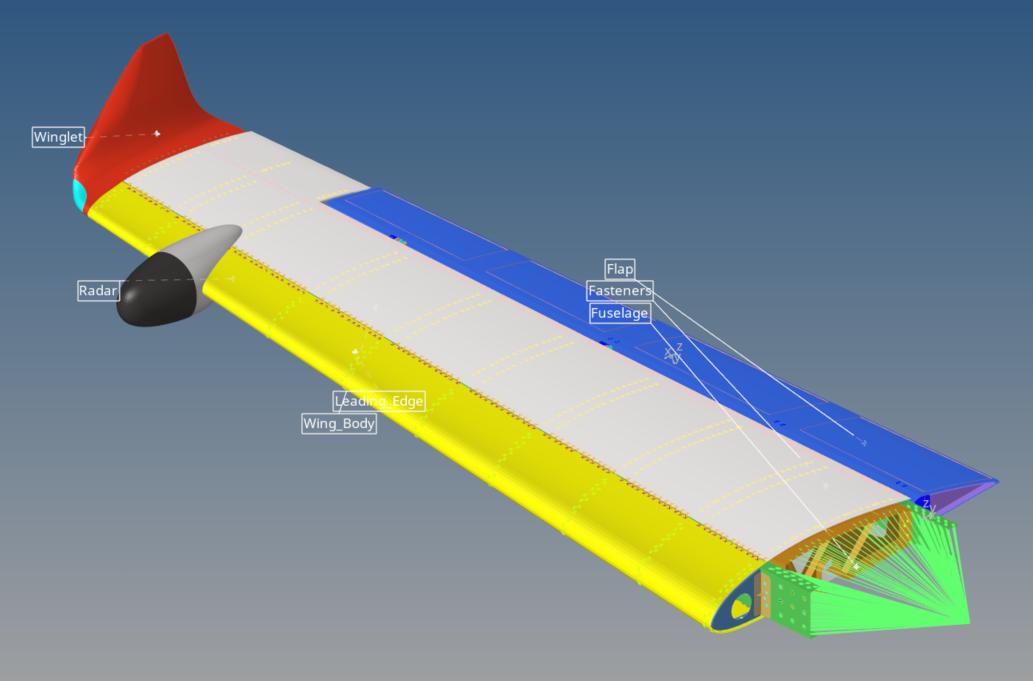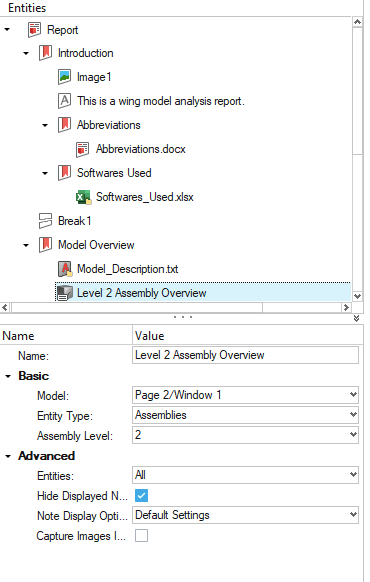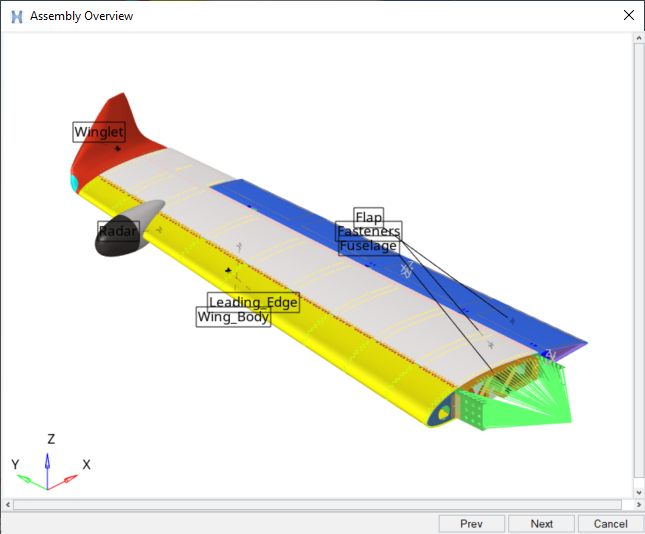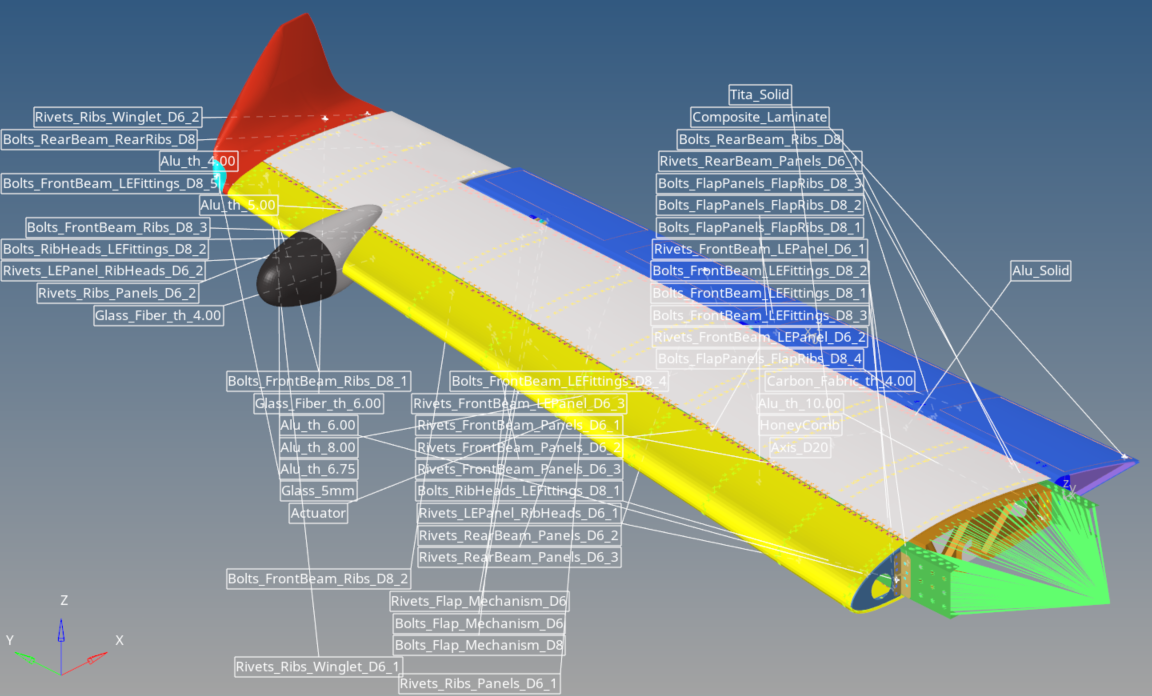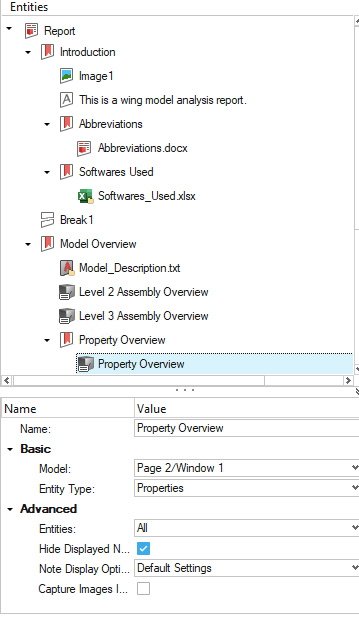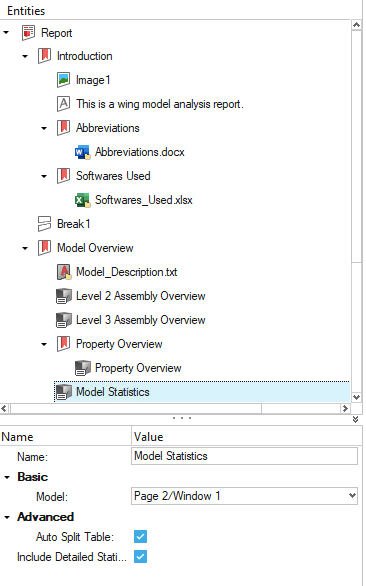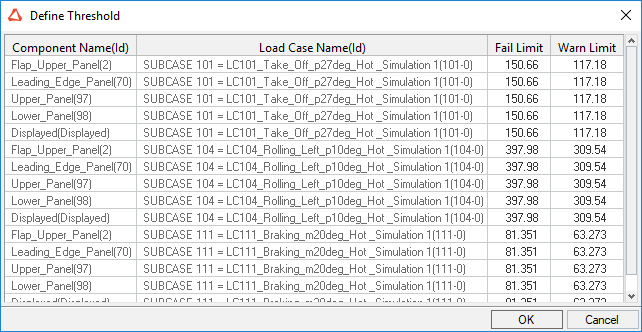Create Document Report
In this tutorial, you will learn how to create, execute, and export a Document report using loop results and entity overview modules.
Create a Document Report
In this exercise, you will: create a Document report tree using chapters, images, text, tables, and modules; execute the report items; and export the Document report.
Launch the Report
In this step, you will launch the report in HyperMesh.
- Start HyperMesh.
- Open the Report ribbon.
-
From the menu bar, select .
The Open Session File dialog opens.
-
Browse and select the Report_Tutorial_Session.mvw
file.
The file opens in the graphics window.
-
Open the Document master file.
Create a Report Tree
In this step, you will create a report tree using Document report items.
-
From the Report ribbon, click New Report and then click
 .
A new chapter is added to the tree under New Report.
.
A new chapter is added to the tree under New Report. - Name the chapter Introduction.
-
Right-click on the Introduction chapter and click
 .
A new image entity is added to the report tree under Introduction.
.
A new image entity is added to the report tree under Introduction. -
In the Entity Editor, define the image entity
properties.
- Name the image Image 1.
- Set Source to Graphics Area.
- Change the image caption to Figure 1 - Wing Model.
- Maintain the default location of the caption.
- Set Model to Page 1/Window 1.
Figure 2. 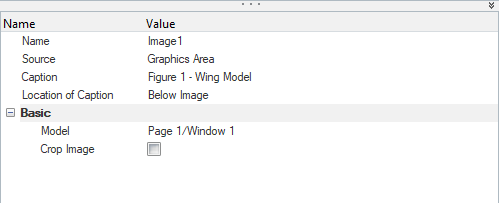
-
Right-click on Image 1 and click
Run.
The image entity is executed, updated, and captured from the HyperMesh window as seen in Figure 3.
Figure 3. 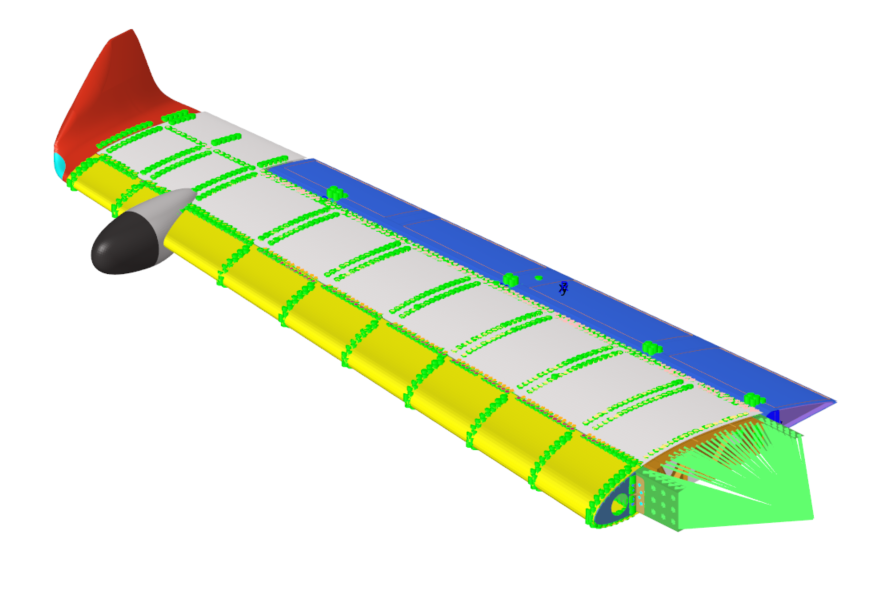
-
Preview the image entity output.
-
Select Introduction chapter and click
 .
A new text entity is added to the report tree under Introduction.
.
A new text entity is added to the report tree under Introduction. -
In the Entity Editor, define the text entity
properties.
-
Preview the text entity.
-
Select Introduction chapter and click
 .
A new chapter is added to the report tree under Introduction.
.
A new chapter is added to the report tree under Introduction. - Name the chapter Abbreviations.
-
Right-click on the Abbreviations chapter and select .
A Word document entity is added to the report tree under Abbreviations.
-
Using the Entity Editor, select a document for the Word
document entity.
- Click File Path.
-
Click
 .
.
- Browse and select the Abbreviations.docx Word file.
- Maintain the default values for the remaining properties.
-
Select Introduction chapter and click
 .
A new chapter is added to the report tree under Introduction.
.
A new chapter is added to the report tree under Introduction. - Name the chapter Softwares Used.
-
SelectSoftwares Used chapter and click from the Report ribbon.
An Excel document entity is added to the report tree under Softwares Used.
-
Using the Entity Editor, select a document for the
Excel document entity.
-
Select Report and click from the Report ribbon.
A break is added in the report tree as seen in Figure 5. Additional chapters will be placed in a new page.
Figure 5. 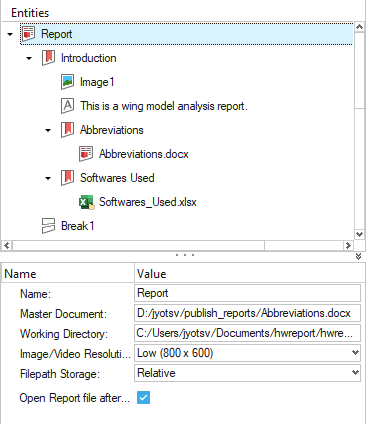
Export the Report
In this step, you will export the report.
-
From the Report ribbon, click
 .
A file browser window opens.
.
A file browser window opens. - Browse and select the required destination folder.
- Enter WingFrame_WordReport as the report title.
- Click Save.
Create the Model Overview Chapter
In this step, you will create the Model Overview chapter and apply modules.
-
From the Report Ribbon, click
 .
A new chapter is added to the report tree below the break added in step 18 of Create a Report Tree.
.
A new chapter is added to the report tree below the break added in step 18 of Create a Report Tree. - Name the chapter Model Overview.
-
Select Model Overview chapter and click Text
File from Add Item group.
A Text file entity is added to the report tree under Model Overview.
-
Using the Entity Editor, select a document for the Text
file entity.
-
Select Model Overview chapter and click from the Report ribbon.
An Entity Overview module is added to the report tree under Model Overview.
-
Using the Entity Editor, define the Entity Overview
module properties.
- Name the module Level 2 Assembly Overview.
- Set Model to Page 2/Window 1.
- Set the Entity Type to Assemblies.
- Set the Assembly Level to 2.
-
Add the image output to the report tree.
-
Preview the image output.
-
Repeat steps 5
through 7 to
create a Level 3 Assembly Overview module and add image output to the report
tree.
Figure 10. 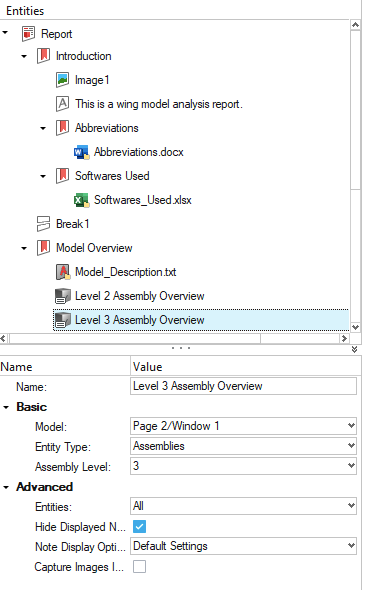
-
Select Model Overview chapter and click
 .
A new chapter is added to the report tree under Model Overview.
.
A new chapter is added to the report tree under Model Overview. - Name the chapter Property Overview.
-
Select Property Overview chapter and click from the Report ribbon.
An Entity Overview module is added to the report tree under Property Overview.
-
Using the Entity Editor, define the Entity Overview
module properties.
- Name the module Property Overview.
- Set Model to Page 2/Window 1.
- Set the Entity Type to Properties.
-
Add the image output to the report tree.
- Preview the image output generated in step 14 by repeating step 8.
-
Select Model Overview chapter and click from the Report ribbon.
A Model Statistics module is added to the report tree under Model Overview.
- In the Entity Editor, set Model to Page 2/Window 1 for the Model Statistics module.
-
Add the model statistics data to the report tree.
- Preview the model statistics data output by repeating step 8.
-
Select Report and click from the Report ribbon.
A break is created in the report tree. Additional chapters will be placed in a new page.
Create the Results Looping Chapter
In this step, you will create the Results Looping chapter and apply modules.
-
Select Report and click
 .
A new chapter is added to the report tree under the break created in step 20 of Create the Model Overview Chapter.
.
A new chapter is added to the report tree under the break created in step 20 of Create the Model Overview Chapter. - Name the chapter Results Looping.
-
Select Results Looping chapter and click from Report ribbon.
A Loop Results module is added to the report tree under Results Looping.
-
Using the Entity Editor, define the Loop Results module
properties.
-
Select Applied Forces and Displacement Results Loop
module and click
 .
An image entity is added to the report tree under Applied Forces and Displacement Results Loop.
.
An image entity is added to the report tree under Applied Forces and Displacement Results Loop. -
Using the Entity Editor, define the image entity
properties.
- Name the image entity Applied Forces.
- Enter Applied Forces as the caption.
- Set Model to Page 3/Window 1.
-
Repeat step 5 to
add a second image entity.
A second image entity is added to the report tree under Applied Forces and Displacement Results Loop.
-
Using the Entity Editor, define the second image entity
properties.
- Name the image entity Displacement Results.
- Enter Displacement Results as the caption.
- Set Model to Page 3/ Window 2.
-
Select Applied Forces and Displacement Results Loop
module and click Run from the Report ribbon.
Tip: You can view the images and the results table using the Preview option.The Loop Results module is executed and the required images and results table are generated.
-
Select Report and click from the Report ribbon.
A break in the report tree is created. Additional chapters will be placed in a new page.
-
Select Results Looping chapter and click from the Report ribbon.
A Loop Results module is added to the report tree.
-
Using the Entity Editor, define the Loop Results module
properties.
-
Select Composite Stress Results Loop module and click
 .
An image entity is added to the report tree under Composite Stress Results Loop.
.
An image entity is added to the report tree under Composite Stress Results Loop. -
Using the Entity Editor, define the image entity
properties.
-
Select Composite Stress Results Loop module and click
Run from the Report ribbon.
Note: The execution process may take several minutes.Tip: You can view the images and the results table using the Preview option.The required images and results table are generated.
Export the Report
In this step, you will export the report.
-
Right-click at Report level and click Expand All.
This expands all child levels in the report tree. The tree structure provides the insight of the report Table of Contents that will be exported as a Document report.
Figure 17. 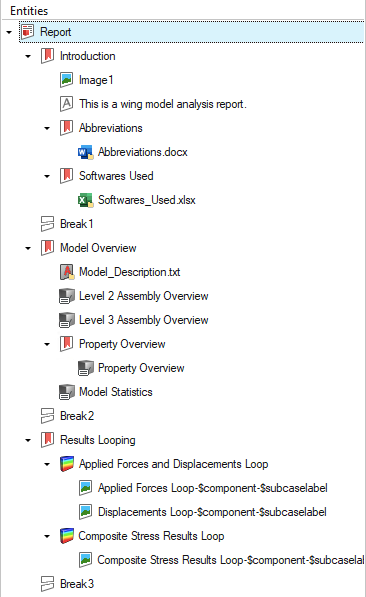
-
In the Report browser, select Report and then click
 from the Report ribbon.
A file browser window opens.
from the Report ribbon.
A file browser window opens. - Browse and select the required destination folder.
- Enter WingFrame_DocumentReport.tpl for the name of the report.
-
Click Save.
A working window opens. The Word file opens automatically. The content is added to the report in a live session. The Document report and a report template (.tpl) are saved.
Reuse Report Templates
In this exercise, you will load a previously saved report template. Also, you will execute a Document report and other report items for the exercise model.
Launch the Report
In this step, you will launch the report in HyperMesh.
- Open the Report ribbon.
-
Load the Document master file.
- From the File menu, select Preferences.
- Select Report from the Common section.
- Browse and select the wordMaster.docx file.
Load the Report Template
In this step, you will load the model, the results file for report execution, and the report template.
-
In the Report ribbon, click
 to Load Report Template.
A file browser window opens.
to Load Report Template.
A file browser window opens. -
Browse and select the WingFrame_DocumentReport.tpl
file.
The Report Settings dialog opens.
- Define the parameters to be used for the report session by using the same model and results files used in Create a Document Report.
-
Confirm the Reporting Directory and Document/Presentation Master Document paths
are correct.
Figure 18. 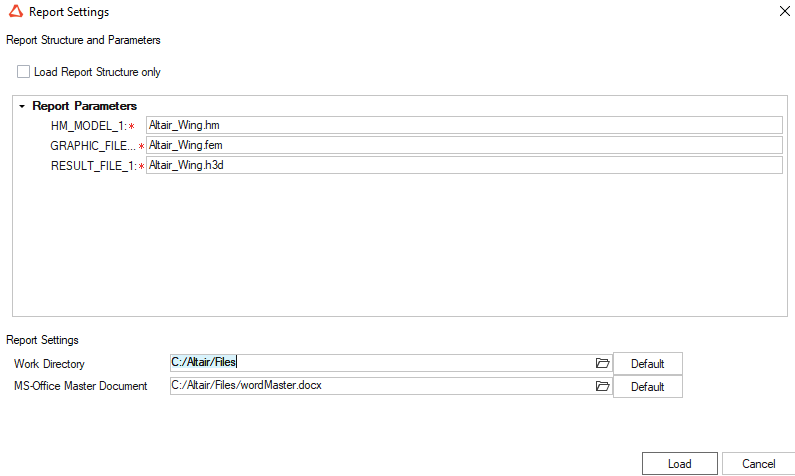
-
Click Load.
A working window appears while the report tree parameters are being loaded to HyperMesh.
-
Right-click on Report and select .
The outputs generated in Create a Document Report and Create a Presentation Report are deleted.
- Expand and verify the properties of each entity.
-
Right click Report and then click
Run.
Tip: You can click
 at any time
to pause the execution.A report item execution of the full report begins. The outputs are added under the respective items.
at any time
to pause the execution.A report item execution of the full report begins. The outputs are added under the respective items.
Export the Report
In this step, you will export the report.
-
In the Report browser, select Report and then click
 on the Report ribbon.
A file browser window opens.
on the Report ribbon.
A file browser window opens. - Browse and select the required destination folder.
- Enter a report name for the report title.
-
Click Save.
The report and a report template (.tpl) are saved.

